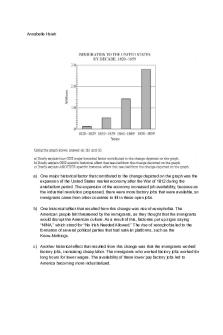Backup of Neuro SAQ - saq PDF

| Title | Backup of Neuro SAQ - saq |
|---|---|
| Author | Nicole Robertson |
| Course | Neuroscience 3 |
| Institution | The University of Edinburgh |
| Pages | 1 |
| File Size | 31.1 KB |
| File Type | |
| Total Downloads | 60 |
| Total Views | 166 |
Summary
saq...
Description
The interaural time difference (ITD) can be used by barn owls to help determine the location of prey. What information is determined from the ITD? How does the Jeffers’s model suggest this information is encoded? Interaural time difference is when the sound comes from anywhere but infront of the owl and arrives at the two ears at slightly different timings. ITD consists of transiet disparity and ongoing disparity. Transient disparity is the difference of the onset and offset of sound whereas the ongoing disparity is the difference between the ears of continuously heard sound. Ongoing disparity is used to determine azimuth, meaning it is responsible for the horizontal localisation of sound. The inferior Colliculus is the part of the auditory system which receives the input of sound, it has space specific cells which are binaural and contain inhibitory and excitatory regions. The ITD’s is determined by time getting processed from the cranial nerve to the nucleus magnocellularis to the nucleus laminaris and finishes at the inferior colliculis. Jeffers asked the question: ‘How does a neuron receive input from 2 ears when they receive it a delay in one ear relative to another?” Jeffers model for encoding LTD’s had two features: Delay lines Coincidence Detectors Jeffers suggested that there is a delay line at the side the input is coming from. The delay line then allows for the opposite side to “play catch up” as it receives the sound input, meaning they both hit the coincidence detectors at the same time, allowing for maximum output. This is what allows for the owl localise prey horizontaly as the coincidence detector which is activated by both inputs at the same time can determine where the stimulus is. In the barn owl the nucleus laminaris may be the anatomical substrate for Jeffers model . This is because the Nucleus Laminaris would act as coincidence Detectors with ipsilateral and contralateral axons from the Nucleus magnocellularis, acting as they delay lines. These then all project to the inferior colliculus, which interprets which neuron is firing and corresponds to a particular ITD, hence allowing the barn owl to localise its prey along its horizontal axis....
Similar Free PDFs

Backup of Neuro SAQ - saq
- 1 Pages

GIT - Anatomy-SAQ answers
- 37 Pages

Immigration SAQ
- 1 Pages

SAQ Chesapeake AND NEW England
- 1 Pages

SAQ - CIE.19, Genetic technology
- 81 Pages

Backup of Chapter 8
- 27 Pages

Fi.Inv. Exzerpt Backup
- 56 Pages

Backup of Chapter 4 Questions
- 2 Pages

Backup of Eng IA1 and
- 4 Pages

Backup of Atmospheres Reading Quiz
- 27 Pages

2do neuro
- 7 Pages
Popular Institutions
- Tinajero National High School - Annex
- Politeknik Caltex Riau
- Yokohama City University
- SGT University
- University of Al-Qadisiyah
- Divine Word College of Vigan
- Techniek College Rotterdam
- Universidade de Santiago
- Universiti Teknologi MARA Cawangan Johor Kampus Pasir Gudang
- Poltekkes Kemenkes Yogyakarta
- Baguio City National High School
- Colegio san marcos
- preparatoria uno
- Centro de Bachillerato Tecnológico Industrial y de Servicios No. 107
- Dalian Maritime University
- Quang Trung Secondary School
- Colegio Tecnológico en Informática
- Corporación Regional de Educación Superior
- Grupo CEDVA
- Dar Al Uloom University
- Centro de Estudios Preuniversitarios de la Universidad Nacional de Ingeniería
- 上智大学
- Aakash International School, Nuna Majara
- San Felipe Neri Catholic School
- Kang Chiao International School - New Taipei City
- Misamis Occidental National High School
- Institución Educativa Escuela Normal Juan Ladrilleros
- Kolehiyo ng Pantukan
- Batanes State College
- Instituto Continental
- Sekolah Menengah Kejuruan Kesehatan Kaltara (Tarakan)
- Colegio de La Inmaculada Concepcion - Cebu




